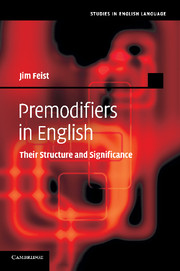Book contents
- Frontmatter
- Contents
- Acknowledgements
- Figures
- 1 Introduction
- 2 Zones, and types of order
- 3 Semantic explanation of unmarked order across the zones
- 4 Syntactic explanation of unmarked order across the zones
- 5 Unmarked order within the Classifier zone
- 6 Free order
- 7 Marked order
- 8 Historical explanation of premodifier order
- 9 Supporting explanations of premodifier order
- 10 Discussion
- 11 Conclusion
- References
- Index
1 - Introduction
Published online by Cambridge University Press: 25 October 2011
- Frontmatter
- Contents
- Acknowledgements
- Figures
- 1 Introduction
- 2 Zones, and types of order
- 3 Semantic explanation of unmarked order across the zones
- 4 Syntactic explanation of unmarked order across the zones
- 5 Unmarked order within the Classifier zone
- 6 Free order
- 7 Marked order
- 8 Historical explanation of premodifier order
- 9 Supporting explanations of premodifier order
- 10 Discussion
- 11 Conclusion
- References
- Index
Summary
The need for this book
This book sets out to explain the nature and arrangement of premodifiers in English nominal phrases by relating their order to their meaning and syntax and to other areas of language, and to show the significance of that structure for other work in linguistics. (‘Premodifiers’ covers uses like ‘the nearby house’; ‘a house nearby’ has a postmodifier; the words the and a are excluded, as determiners.)
The book starts from three facts about English that call for explanation. A music reviewer (cited in the British National Corpus) once described the tambourine as ‘your actual tinny round percussion instrument’. It is generally agreed among linguists and nonspecialist users of language that the order of modifiers in such a phrase cannot be varied freely: we cannot grammatically say *‘your percussion actual round tinny instrument’ or *‘your tinny round percussion actual instrument’, for example. There are evidently rules of some sort for the order; so the fundamental thing to be explained about the order of premodifiers in English nominal phrases is the nature of the rules.
- Type
- Chapter
- Information
- Premodifiers in EnglishTheir Structure and Significance, pp. 1 - 7Publisher: Cambridge University PressPrint publication year: 2011



